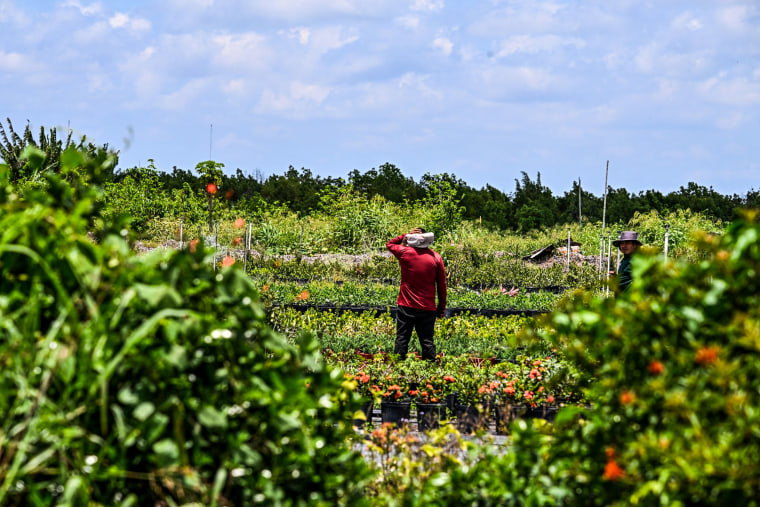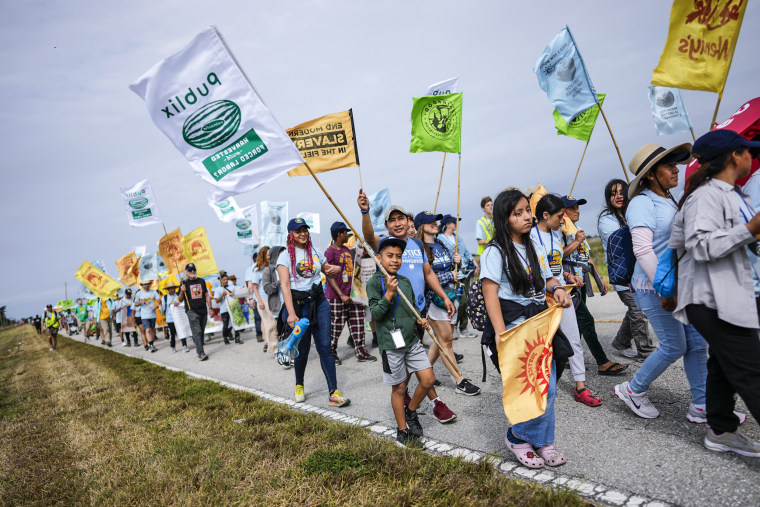Miriam Jordan
Fri, November 12, 2021

Steve Rosenthal, a three-term mayor of Indianola, Miss., stands for a portrait near City Hall on Wednesday, Oct. 27, 2021. (Sarahbeth Maney/The New York Times)
INDIANOLA, Miss. — For more than a quarter-century, Richard Strong worked the fertile farmland of the Mississippi Delta, just as his father and his grandfather did, a family lineage of punishing labor and meager earnings that stretched back to his enslaved ancestors brought from Africa.
He tilled the soil, fertilized crops and irrigated the fields, nurturing an annual bounty of cotton, soybeans and corn for a prominent farming family. “I’ve been around farming all my life,” Strong said. “It’s all we knew.”
Black families with deep connections to the Delta have historically been the ones to perform fieldwork. That began to change about a decade ago, when the first of dozens of young, white workers flew in from South Africa on special guest worker visas. Strong and his co-workers trained the men, who by last year were being lured across the globe with wages of more than $11 an hour, compared with the $7.25 an hour that Strong and other Black local workers were paid.
Growers brought in more South Africans with each passing year, and they are now employed at more than 100 farms across the Delta. Strong, 50, and several other longtime workers said they were told their services were no longer needed.
“I never did imagine that it would come to the point where they would be hiring foreigners, instead of people like me,” Strong said.
From the wheat farms in the Midwest to the citrus groves in California’s Central Valley, growers have increasingly turned to foreign workers as aging farmworkers exit the fields and low-skilled workers opt for jobs in construction, hospitality and warehouses, which offer higher pay, year-round work and, sometimes, benefits.
The agricultural guest worker program, known by the shorthand H-2A, was once shunned by farmers here and elsewhere as expensive and bureaucratic. But the continuing farm labor shortages across the country pushed H-2A visas up to 213,394 in the 2020 fiscal year, from 55,384 in 2011.
“Our choice is between importing our food or importing the workforce necessary to produce domestically,” said Craig Regelbrugge, a veteran agricultural industry advocate who is an expert on the program. “That’s never been truer than it is today. Virtually all new workers entering into the agriculture workforce these days are H-2A workers.”
In the Mississippi Delta, a region of high unemployment and entrenched poverty, the labor mobility that is widening the pool of workers for growers is having a devastating effect on local workers who are often ill-equipped to compete with the new hires, often younger and willing to work longer hours.
The new competition is upending what for many has been a way of life in the rich farmlands of Mississippi. “It’s like being robbed of your heritage,” Strong said.
In Mississippi, where the legacy of slavery and racism has long pervaded work in the cotton fields, a federal lawsuit filed by Strong and five other displaced Black farmworkers claims that the new foreign workers were illegally paid at higher rates than local Black workers, who it said had for years been subjected to racial slurs and other demeaning treatment from a white supervisor.
Two additional plaintiffs are preparing to join the suit, which says farmers violated civil rights law by hiring only white workers from South Africa, a country with its own history of racial injustice.
“Black workers have been doing this work for generations,” said Ty Pinkins, a lawyer at the Mississippi Center for Justice, which is representing the Black farmworkers in the lawsuit. “They know the land, they know the seasons, they know the equipment.”
A region steeped in poverty
A vast flood plain, the Mississippi Delta boasts some of the country’s richest soil. It also is the poorest pocket of the poorest state. In Indianola, a town of almost 10,000 about 95 miles north of Jackson, the median household income is $28,941.
The hometown of blues legend B.B. King, Indianola is the seat of Sunflower County, where empty storefronts line forlorn downtowns and children play outside crumbling shacks.
The region, which is more than 70% Black, remains rigidly segregated. Black children attend underfunded public schools while white students go to private academies. Black and white families bury their dead in different cemeteries.
The Delta is only one of a number of places where South Africans have been hired for agricultural work in recent years. While Mexicans accounted for the largest share of last year’s H-2A visas, or 197,908, the second-largest number, 5,508, went to South Africans. Their numbers soared 441% between 2011 and 2020.
Garold Dungy, who until two years ago ran an agency that recruited foreign farmworkers, including for Pitt Farms, the operation that employed Strong and the other plaintiffs, said South Africans represented the bulk of his business. They are “the preferred group,” he said, because of their strong work ethic and fluency in English.
Under the program, growers can hire foreign workers for up to 10 months. They must pay them an hourly wage that is set by the Labor Department and varies from state to state, as well as their transportation and housing.
Farmers must also show that they have tried, and failed, to find Americans to perform the work and they must pay domestic workers the same rate they are paying the imported laborers.
According to the Black workers’ lawsuit, Pitt Farms paid the South Africans $9.87 an hour in 2014, a rate that reached $11.83 in 2020. The plaintiffs who worked in the fields were paid the federal minimum wage of $7.25 an hour or $8.25 on weekends, plus occasional bonuses.
Both Walter Pitts, a co-owner of Pitts Farms, and the farm’s lawyer, Timothy Threadgill, declined to discuss the farm’s hiring strategy because of the pending litigation.
The reliance on South Africans may reflect the nature of agriculture and the demographics in the Mississippi Delta, compared to places like California.
“In the Mississippi Delta, row-crop production requires fewer workers but workers who have skills to use machinery and equipment,” said Elizabeth Canales, an agricultural extension economist at Mississippi State University. “We hardly have any Latinos in this remote region. Naturally, it’s easier to hire South Africans where language will not be a barrier, especially because in this area, you have a very small Spanish-speaking population.”
The South Africans arrived in the region willing to work weeks that sometimes stretched to 75 hours or more, grueling schedules that might have been difficult for older local workers to maintain, industry analysts said.
There was initially no public controversy over the program in Indianola. Growers in the region described the South Africans as “good workers,” said Steve Rosenthal, a three-term mayor of Indianola who lost his bid for reelection in October. Until the lawsuit was filed, he did not realize that some Black workers had been let go.
“If you have a man that you’ve trained and worked with for years and he knows how to get stuff done,” he said, “how in good conscience can you bring somebody over and pay him more than a man that’s been with you five, eight, 10 years?”
A long family history in the Delta
The Strong family has worked for generations for the Pitts family, which has farmed in the Mississippi Delta for six decades. Richard Strong’s grandfather Henry and grandmother Isadora worked their land. So did his father and his uncle.
Strong and his brother got hired in the 1990s; he eventually operated not only tractors, but big equipment like combines and cotton pickers. He mixed chemicals to control weeds and pests. He ran irrigation pivots in 19 fields, covering some 3,000 acres. He rose to manager, driving across the farm to verify that everything was in working order.
When Strong first heard that Africans were coming to work on the farm, about eight years ago, “I didn’t question it. I just went along doing my job,” he said.
But when four white men showed up, they were not the Africans he had expected. Even so, Strong said, the men, a good 20 years younger than him, were “cool guys.”
He taught the men how to properly plow, how to input GPS settings into the tractors’ navigation systems, how to operate the irrigation system so just the right amount of water was sprinkled on the crops.
Over the next few years, more South Africans came, until more than half the farm’s workforce was there on foreign visas.
One of them was Innes Singleton, now 28, who learned about the opportunity to work in Mississippi from a friend in 2012.
He had recently finished secondary school and did not know what to do next.
He arrived in Indianola in early 2013, and is now earning $12 an hour, making in one week what would take a month for him to earn in South Africa, where the unemployment rate now exceeds 30%.
“I learned a lot here,” he said, adding that he sometimes had to work up to 110 hours a week. South Africans now do the main work on the farm, he said, and four locals “help us out.”
The end of an era
After the 2019 season, Strong traveled to Texas to visit his ailing father-in-law. When he returned, the Pitts Farm truck that he drove had disappeared from outside the house he had rented from the grower for about a year. He was told to vacate and was not offered work for the 2020 season.
A year later, others were let go, including his brother, Gregory, who said he had devoted much of his life to Pitt Farms.
“I gave them half my life and ended up with nothing,” he said. “I know everything on that place. I even know the dirt.”
Andrew Johnson, another plaintiff in the lawsuit, is 66 and said he had worked 20 years at the farm.
“I used to work rain or shine or anything,” he said.
But before the 2021 season began, he said, one of the Pitts owners told him, “he didn’t need me no more.”
Since the lawsuit was filed, other Black workers have come forward, saying they had labored in the fields and catfish farms of the Delta before unfairly losing their jobs, Pinkins, the lawyer, said.
In late October, as the harvesting season came to a close, 18-wheelers in Indianola rumbled down the highway, loaded with bales of cotton. Driving alongside the farm where he spent 24 years, Strong scanned the rows of neatly carved earth as far as the eye could see. “I put in all that,” he said, with a certain pride.
Then a tractor passed by, a young South African man at the wheel, and Strong looked away. “I miss working the land,” he said.
© 2021 The New York Times Company







